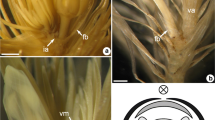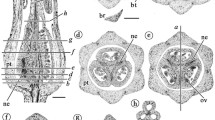Abstract.
In the flower of Hydrolea palustris, unusually orientated with one sepal abaxially, organogenesis starts in following sequence: five sepals (2/5 sequence), five simultaneously initiated alternating petals, five episepalous stamens, two (seldom three) carpels forming a coenocarpous septate gynoecium. The two carpels are orientated rather in the diagonal floral plane than in the median one. Petal primordia fuse very late by forming interprimordial bridges (late sympetaly!). Many ovules develop on considerably widened placentas. On the very basis of the superior ovary a five-humped nectary disk is formed.
Within Solanales (APG II 2003) late sympetaly, an intrastaminal disk and a 2-carpellate, septate, superior ovary are found in Hydroleaceae, Convolvulaceae, and Solanaceae. Enlarged axile placentas characterize Hydrolea, Solanaceae, and Sphenocleaceae but Sphenocleaceae differ considerably by early sympetaly. Montiniaceae differ by having a choripetalous corolla. Nearly diagonal orientation of the carpels seems to relate Hydrolea close to Solanaceae, but the orientation of the calyx is different.
Similar content being viewed by others
Author information
Authors and Affiliations
Corresponding author
Rights and permissions
About this article
Cite this article
Erbar, C., Porembski, S. & Leins, P. Contributions to the systematic position of Hydrolea (Hydroleaceae) based on floral development. Plant Syst. Evol. 252, 71–83 (2005). https://doi.org/10.1007/s00606-004-0263-7
Received:
Accepted:
Published:
Issue Date:
DOI: https://doi.org/10.1007/s00606-004-0263-7




